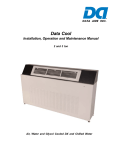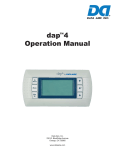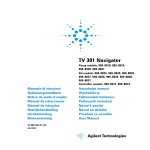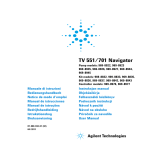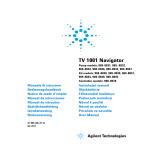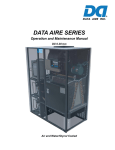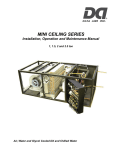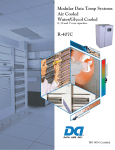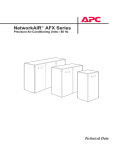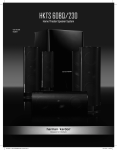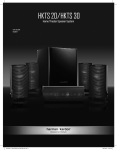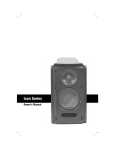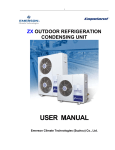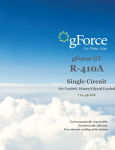Download Data Aire DAFC-11 Unit installation
Transcript
DATA TEMP AND MODULAR DATA TEMP Operation and Maintenance Manual Air and Water/Glycol Cooled CONGRATULATIONS ON THE SELECTION OF A DATA AIRE PRECISION ENVIRONMENTAL CONTROL SYSTEM. PROPER INSTALLATION, OPERATION AND MAINTENANCE OF THIS EQUIPMENT WILL ENSURE YEARS OF OPTIMAL PERFORMANCE. This manual is intended to assist trained service personnel by providing necessary guidelines for this particular equipment. Service to Data Aire units should be done by qualified individuals with an adequate background in areas such as HVAC, electrical, plumbing and electronics, as applicable. Special care should be given to those area where this symbols appear. Data Aire, Inc. reserves the right to make design changes for the purposes of product improvement, or to withdraw any design without notice. 2 Table of Contents 1.0 1.1 1.2 1.3 1.4 1.4.1 1.4.2 1.5 1.6 1.7 INSTALLATION .................................................................................................. 6 Room Considerations ............................................................................................ 6 Inspection .............................................................................................................. 6 Rigging .................................................................................................................. 6 Locating the Unit ................................................................................................... 7 Downflow Units...................................................................................................... 7 Upflow Units .......................................................................................................... 8 Paperwork ............................................................................................................. 8 Storage .................................................................................................................. 8 Model Identification ............................................................................................... 9 2.0 2.1 2.1.1 2.1.2 2.1.3 2.1.4 2.1.5 2.1.6 2.2 2.2.1 2.2.2 2.2.3 2.3 2.4 2.5 2.5.1 2.5.2 2.6 2.7 PIPING .............................................................................................................. 10 Split Air Cooled Unit Piping ................................................................................. 10 Discharge Lines................................................................................................... 10 Liquid Lines ......................................................................................................... 10 Suction Lines.........................................................................................................11 Connection Sizes, Air Cooled Units......................................................................11 Field Piping, Remote Condenser .........................................................................11 Field Piping, Remote Condensing Unit ............................................................... 12 Water/Glycol Cooled Unit Piping ......................................................................... 12 Field Piping, Glycol System ................................................................................. 13 Connection Sizes, Water/Glycol Cooled Units ..................................................... 13 Connection Sizes, Fluid Coolers .......................................................................... 13 Auxiliary Chilled Water Coil Piping ...................................................................... 14 Condensate Drain Piping .................................................................................... 14 Humidifier Piping ................................................................................................. 15 Steam Generator Humidifier ................................................................................ 14 Dry Steam Humidifier ........................................................................................... 15 Leak Testing ........................................................................................................ 15 Evacuation........................................................................................................... 15 3.0 ELECTRICAL CONNECTIONS ........................................................................ 16 Electrical Service. . .............................................................................................. 16 Nameplate Ratings .............................................................................................. 16 Grounding............................................................................................................ 16 Voltage Tolerance ................................................................................................ 16 Auxiliary Control Wiring ....................................................................................... 16 Remote Shutdown ............................................................................................... 16 Remote Alarm Contacts ...................................................................................... 17 Remote Sensors.................................................................................................. 17 Condensate Pumps ............................................................................................. 17 Condensate Probe .............................................................................................. 17 Water Sensing Cable .......................................................................................... 17 3.1 3.2 3.3 3.4 3.5 3.6 3.7 3.8 3.9 3.10 3.11 3 Table of Contents, cont’d 4 4.0 4.1 4.1.1 4.1.2 4.2 4.2.1 4.2.2 4.3 4.3.1 4.3.2 4.4 4.5 4.5.1 4.5.2 4.5.3 CHARGING ........................................................................................................ 18 Voltage Phase Check .......................................................................................... 18 Evaporator ........................................................................................................... 18 Secondary Heat Exchanger ................................................................................ 18 Air Cooled Systems ............................................................................................. 18 Fan Speed Control System Charging (Unit with Remote Outdoor Condenser) .. 18 Flooded System Charging ................................................................................... 19 Water/Glycol Cooled Systems ............................................................................. 20 Water/Glycol Cooled System Charging ............................................................... 20 Factory Charge for Water/Glycol Cooled Systems .............................................. 21 Refrigerant Handling ........................................................................................... 21 Important Refrigeration Components .................................................................. 21 Expansion Valve .................................................................................................. 21 High Pressure Cutout Switch .............................................................................. 21 Low Pressure Cutout Switch ............................................................................... 22 5.0 5.1 5.1.1 5.1.2. 5.2 5.3 5.4 GLYCOL SYSTEMS ........................................................................................... 23 Glycol Concentration ........................................................................................... 23 Internal (Fluid) Volume - Downflow Units ............................................................ 23 Internal (Fluid) Volume - Upflow Units ................................................................. 23 Fluid Cooler Internal Volume ............................................................................... 24 Copper Piping Internal Volume............................................................................ 24 Freezing Point of Aqueous Solutions .................................................................. 24 6.0 6.1 6.2 6.3 CONTROLS ....................................................................................................... 25 Microprocessor Control Panel ............................................................................. 25 Secondary Heat Exchangers............................................................................... 25 Wiring Diagrams .................................................................................................. 25 7.0 7.1 7.2 7.3 7.4 7.5 7.6 7.7 REGULAR MAINTENANCE ITEMS .................................................................. 26 Air Filters ............................................................................................................. 26 Belts .................................................................................................................... 26 Bearings .............................................................................................................. 26 Humidifier Canisters ............................................................................................ 26 Fuses................................................................................................................... 27 Heating Elements ................................................................................................ 27 Refrigerant Filter Drier ......................................................................................... 27 8.0 WARRANTY ....................................................................................................... 28 9.0 CONTACT DATA AIRE ...................................................................................... 29 Table of Contents, cont’d RECOMMENDED LINE SIZING CHART for AIR COOLED SPLIT SYSTEMS ................... 30 TEMPERATURE PRESSURE CHART................................................................................ 31 SUPERHEAT and SUCTION PRESSURE TROUBLE SHOOTING GUIDE ....................... 32 MAINTENANCE INSPECTION CHECKLIST ...................................................................... 33 NOTES ............................................................................................................................ 34 5 1.0 INSTALLATION There is no intent on the part of Data Aire, Inc. to define local codes or statutes which may supersede common trade practices. The manufacturer assumes no responsibility for their interpretation. Consult local building codes and the National Electrical Code (NEC) for special installation requirements. 1.1 Room Considerations Precision air conditioning equipment is designed to control spaces within close tolerances of temperature and humidity. However, the room must be built with a proper vapor barrier. A film of polyethylene is often used on walls and ceilings. Floors must be painted with vapor seal paint. All doors to the controlled space should be equipped with weather seals to prevent the infiltration of nonneutral conditioned air from entering the space. Failure to provide a vapor barrier can compromise the ability to control space conditions. Introduction of outside air into the controlled space should be minimized. Outside air in excess of 5% of the total circulated air volume can have a significant effect on the overall space conditions and result in poor space control. All outside air that is introduced should be conditioned to the humidity and temperature parameters of the computer room air conditioner (CRAC) unit setpoints to maintain the room’s design conditions. 1.2 Inspection This equipment has been factory run-tested and has gone through a comprehensive inspection prior to its packaging and shipment to ensure that it arrives in excellent condition. However, shipping damage can occur and a visual inspection of the outer crating immediately upon delivery should be performed. Note any external damage or other transportation damage on the freight carrier’s forms. Inspect the unit itself for internal damage. A claim should be filed with the shipping company if the equipment is damaged or incomplete. Loose items such a remote control panels, disconnect switch handles and spare belts are packed inside the unit. Refer to the yellow shipping tag located on the electrical section panel. Freight damage claims are the responsibility of the purchaser. Action to recover losses should be filed immediately. Please notify factory personnel of any claims. 1.3 Rigging Move the unit in its upright position to the installation site. It is recommended that the unit be protected from damage to the decorative doors during any storage or moving. Removal of the decorative doors is easily accomplished and may be done when moving the equipment. The shipping skid should be left in place if the unit is being moved with a forklift. If the unit is being lifted, use spreader bars to prevent damage to the doors and panels. The unit has 3/4” holes in the shipping skid to which casters with 3/4” stems can be attached. This allows easy movement down halls, into elevators and through doorways. If (height) clearance is a 6 problem, the casters may be inserted directly into the bottom of the 1” tubular steel corner posts at the bottom of the unit. Warning: Improper lifting or moving of equipment may result in damage to decorative doors, panels or frame members. 1.4 Locating the Unit When installing the unit, sufficient space must be allowed for airflow clearance, wiring, plumbing and service access. It is recommended that each side and front door have a clearance of at least 30” to allow the doors to swing open and for servicing the unit. The doors on some sides may not require as much service clearance. Refer to the particular unit component breakdown drawings for assistance. Rear clearance is not required but 1 to 2 inches of clearance is suggested. For best air distribution the unit should be centered against the longest wall, as close to the heat load as possible unless the unit is ducted. The unit should not be placed near any corner of the room or at the end of a long, narrow room. Multiple units should be evenly spaced as far apart as possible. NOTE TO INSTALLING CONTRACTOR: Condensation formation and frequent humidifier flushing are normal functions of this equipment. Proper drain connections must be made to ensure proper removal. Unit will require water connections for condensation removal and possibly for humidifier makeup water, condenser water and/or hot water. Installation of units should be avoided above electronic equipment that sustain water damage should be avoided at all times. 1.4.1 Downflow Units Downflow units will typically sit on an elevated flooring system commonly referred to as a raised floor. The unit discharges air downward which pressurizes the raised floor area and channels air upward through perforated floor tiles. Location and quantity of perforated tiles will dictate proper air distribution. If the raised floor is strong enough to support the unit and local codes permit such installations, the unit can be placed directly on top with cutouts made for discharge openings. There may be additional support required in the form of adjustable (optional) jackstands. Jackstands are adjustable, threaded leveling rods which support the unit in each of the corners and in the center on longer length units. Tighten the lock-nuts provided with each jackstand. The base plate can rest on the floor or on vibration isolation pads. (Optional) floorstands are also a way of supporting the unit. These are ordered to the height of the floor with leveling rods to allow adjustment. The floorstand has lips at each corner to align the unit which is place on top. It is recommended that the unit frame be bolted or screwed to the floorstand from below. Local codes may dictate this procedure. After installation, the raised floor is typically built around the unit. The raised floor serves as the distribution plenum for air on downflow units. Cables, piping, wiring raceways, inadequate floor height (raised floors less than 12 inches in height are not recommended) and any other restrictions can inhibit proper air flow. Care should be taken to avoid any air restrictions. 7 1.4.2 Upflow Units Upflow units will typically be supported by vibration isolation pads and/or floorstands which may also include leveling screws. An (optional) air discharge plenum may be factory provided. The plenum ships loose and must be field attached at the top of the unit frame. Alternately, an air distribution plenum must be field fabricated with supply grilles to distribute the air. Units are shipped with a drive package to overcome the external static pressure (ESP). Adjustments to the blower speed may be required to adjust the actual site conditions. 1.5 Paperwork Each Data Aire unit is shipped with an envelope with start-up sheets that are required to be completed during installation and start-up. Also included with the paperwork is the warranty and information that includes wiring diagrams, specific component literature, warranty registration cards and a copies of the unit and microprocessor Installation/Operation and Maintenance manuals. A yellow tag is attached to the outside decorative door to indicate components that may have been packaged and shipped loose within the unit cabinet (y-strainers, jackstands, condensate pumps, flow switches and other components not factory installed). It is the responsibility of the installing contractor to return the start-up sheets and warranty registration card to Data Aire for proper unit warranty activation. Failure to do so may cause delays and in some cases void the warranty. 1.6 Storage Data Aire equipment is shipped ready for immediate installation. In some instances it may be necessary to store the equipment for a short period of time. If you must store the equipment it should be done in a dry area, out of the weather, protected from damage by other equipment in storage or transportation equipment and never stacked. Frequent relocation should be avoided. If equipment is stored longer than thirty (30) days special precautions must be taken to avoid coil damage. All coils should be charged and sealed with a low pressure (1 – 3 PSIG) inert gas (such as nitrogen). This prevents contaminants from entering the coils. When the seal is broken at installation the rush of escaping gas verifies the coil is still leak free. If coils are not charged and sealed, condensation mixes with air pollutants forming a weak acid and over time can cause pinhole leaks to develop in the coil tubes. When equipment is installed after storage caution should be taken to inspect and replace, if required, rubber hoses (humidifier) and belts. All moving parts (blowers and motors) should be hand tested to ensure that they are free and clear of debris prior to start-up. Finally, verify that lubrication is fresh and full. 8 1.7 Model Identification Data Temp Modular Data Temp 9 2.0 PIPING 2.1 Split Air Cooled Unit Piping Refer to the attached line sizing chart on page 30 for a guideline for sizing refrigerant lines. The ultimate responsibility for line sizing selection is that of the installing contractor or the project engineer. Data Aire does not assume this responsibility. The chart covers distances up to 200 equivalent feet. For installations greater than this distance, consult ASHRAE or similar references. Standard piping practices must be used to ensure proper oil return and efficient operation. The interconnecting lines to the remote air cooled condenser or condensing unit must be installed by a qualified refrigeration mechanic. 2.1.1 Discharge Lines Discharge lines, also called hot gas lines, should be trapped at the top (inverted) and bottom, as well as every 15 to 20 feet of vertical rise. Discharge line check valves are recommended on all installations, especially those where there are long pipe runs or cold climate. Check valves should be installed 6 to 10 feet from the compressor. The discharge, suction and liquid lines need to be refrigerant grade copper and in accordance with local code. All refrigeration piping should be installed with high temperature brazed joints. When brazing, a supply of nitrogen gas needs to be fed through the refrigerant lines. Be sure to open the other end of the refrigerant line to allow the nitrogen to bleed off and not pressurize the piping. Prevailing good refrigeration practices should be employed for piping support, leak testing, dehydration and charging of the refrigerant circuits. During the installation the lines should be capped off and filled with dry nitrogen at the end of each day’s work or until the system is completed and sealed. Data Aire recommends a silver/phosphorus/copper alloy with 5 to 15% silver to be used to braze the refrigerant line sets to the indoor and outdoor units. Nitrogen needs to be flowing through the lines to eliminate carbon deposit build-up of the joints. Carbon could contaminate the refrigerant and restrict the metering device. Piping must be supported within 18” of the inlet and outlet connections. The inlet connection is located on the top header of all units. The discharge outlet is located at the bottom of the header. The discharge line pressure drop should not exceed 6 PSIG for R-407C and 9 PSIG for R-410A. Recommended gas velocity for proper oil return is 1,000 FPM. Slope horizontal lines downward in the direction of refrigerant flow, 1/2” for every 10 feet of line length. Discharge lines do not require insulation but due to the high temperatures of the refrigerant inside the line, the pipes may be insulated to protect against burns to individuals near or around the lines. 2.1.2 Liquid Lines Liquid lines are determined by pressure drop and velocity. The liquid line pressure drop for R-407C should not exceed 5 PSIG. For systems with R-410A, the pressure drop should not exceed 9 PSIG. The recommended velocity should be between 200 and 300 FPM. To avoid excessive liquid line pressure drop, the air cooled condenser should be located above or at the same level as the evaporator. Condenser installations more than 10 feet below the evaporator are not recommended. Insulation of liquid lines is not required but can be useful in preventing condensation from forming in cold climates and to avoid flashing on long pipe runs. 10 2.1.3 Suction Lines Some applications call for the compressor to be mounted as part of the condenser, more commonly referred to as a condensing unit. Such require field piping of liquid and suction lines. Suction lines are trapped similarly to discharge lines. Common practice for suction line selection and installation should be followed. Suction lines should always be insulated. 2.1.4 Connection Sizes, Air Cooled Units MODEL DTAD/U-02 DTAD/U-03 DTAD/U-04 DTAD/U-05 DTAD/U-08 DTAD/U-10 DTAD/U-13 HOT GAS LINE 1/2” 1/2” 1/2” 1/2” 3/4” 3/4” 3/4” LIQUID LINE 1/2” 1/2” 1/2” 1/2” 5/8” 5/8” 5/8” SUCTION LINE 3/4” 3/4” 3/4” 3/4” 1-3/8” 1-3/8” 1-3/8” Note: Units will have a liquid line and either a hot gas or suction line Field connections at the indoor evaporator and remote condenser or condensing unit will not necessarily be the same as the field pipe size required. In some cases these sizes will vary significantly. 2.1.5 Field Piping, Remote Condenser 11 2.1.6 Field Piping, Remote Condensing Unit 2.2 Water/Glycol Unit Piping The required field installed condenser water pipe sizes may or may not be the same as the connections at the evaporator section or fluid cooler (refer to Sections 2.2.2 and 2.2.3 for connection sizes). Water pipe sizes will depend on the length of pipe required and the calculated pressure drop of peripheral components. Water cooled units may be connected to building water or tower water sources. Pipe size will depend of run and the maximum water flow required. Shut-off valves (field Provided) Should be installed within a few feet of the inlet and outlet connections of the evaporator to allow the unit to be isolated for service. Drain/fill valves should be located at the lowest point on the connected piping. All water/glycol units are shipped with plate/fin heat exchangers as standard equipment. A strainer is shipped loose and is to be field installed in the supply line with shut-off valves (field provided) before and after the strainer. The strainer and water/glycol piping must be cleaned on a periodic basis. If the unit is shipped with optional shell and tube condenser, strainers are not required or shipped with the unit. All water pipes have a cap installed on the end of the pipe for pressure testing the system. These caps need to be removed before installing the piping to the units. Use a tube cutter for smaller pipes and a reciprocating saw with a metal cutting blade for larger pipe sizes or if there is a clearance problem. All connections need to be cleaned before connections are brazed together. NOTE: One of the most common problems in a water/glycol system is the presence of air in the condenser loop. Air vents must be installed in various locations in the piping system to purge the air. 12 Water/glycol system piping may include a centrifugal pumps (or pumps for redundancy). Pumps must be primed before operating per the pump manufacturer’s guidelines. 2.2.1 Field Piping, Glycol System 2.2.2 Connection Sizes, Water/Glycol Cooled Units Evaporator Model DTW/G-02 DTW/G-03 DTW/G-04 DTW/G-05 Water IN and Out Connections, O.D. 3/4” 3/4” 1-1/8” 1-1/8” Evaporator Model DTW/G-08 DTW/G-10 DTW/G-13 Water IN and Out Connections O. D. 1-5/8” 1-5/8” 1-5/8” 2.2.3 Connection Sizes, Fluid Coolers Fluid Cooler Water IN and OUT Fluid Cooler Water IN and OUT Model Connections, O.D. Model Connections, O.D. DAFC-06 1-5/8” DAFC-37 2-5/8” DAFC-07 1-5/8” DAFC-40 2-5/8” DAFC-09 1-5/8” DAFC-44 2-1/8” DAFC-11 2-1/8” DAFC-50 2-5/8” DAFC-15 2-1/8” DAFC-57 2-5/8” DAFC-17 2-5/8” DAFC-61 2-5/8” DAFC-21 2-1/8” DAFC-75 2-5/8” DAFC-24 2-5/8” DAFC-80 2-5/8” DAFC-28 2-1/8” DAFC-88 2-5/8” DAFC-30 2-1/8” DAFC-100 2-5/8” 13 NOTE: Models DAFC-57 and larger are double-wide units. Although the header connection for each section is 2-5/8” O.D., each unit comes with a factory provided manifold kit with 3-1/8” O.D. field connections. 2.3 Auxiliary Chilled Water Coil Piping Units with optional auxiliary chilled water cooling coil require a separate source of chilled water. The chilled water connection sizes will be the same as those listed for the condenser water (see Section 2.2.3). Units with optional Energy Saver coil typically have shared or common piping with the condenser supply and therefore do not require a separate cooling source. All water pipes have a cap installed on the end of the pipe for pressure testing the system. These caps need to be removed before installing the piping to the units. Use a tube cutter for smaller pipes and a reciprocating saw with a metal cutting blade for larger pipe sizes or if there is a clearance problem. All connections need to be cleaned before connections are brazed together. 2.4 Condensate Drain Piping Every indoor evaporator section is provided with a 3/4” copper stub for condensate removal. A union is recommended at the field connection which will permit easy disconnection from the unit for cleaning. A trap should be built into the drain line to prevent air from backing up into the unit. Drain lines should be pitched downward not less than 1/4” for each ten feet of horizontal run. Do not reduce the size of the drain line. Some applications have no convenient means of allowing a gravity drain. In this case, a condensate pump can be used. Condensate pumps are either factory mounted and wired or shipped loose. Factory mounted condensate pumps do not require a separate power source. Condensate pumps shipped loose (or field provided) typically require a dedicated 110 volt power source. Field pipe connections must be made to the pump discharge connection. A check valve must be installed to prevent short cycling. (Also see condensate pump electrical requirements in Section 3.9) 2.5 Humidifier Piping 2.5.1 Steam Generator Humidifier The standard humidifier on Data Temp and Modular Data Temp systems is a steam generator type with a disposable cylinder. The humidifier make-up water should be brought to the humidifier through the field connection opening using 1/4” copper tubing. A compression fitting is provided at the humidifier. A shut-off valve should be provided outside the air conditioner to allow disconnection for service. An in-line water pressure regulator and strained should be installed. Water pressure should be set between 30 and 80 PSI. The humidifier has a drain at the bottom which is factory piped to the main condensate drain line. The dispersion tube also has a drain line. No additional field piping is required. 14 2.5.2 Dry Steam Humidifier Units with optional dry steam humidifiers require a strainer on the inlet steam line. An outlet connection with a field provided steam trap is also required. Steam pressure is typically 10 to 15 PSI. 2.6 Leak Testing No installation is complete until the entire system has been thoroughly checked for leaks. This includes checking refrigerant tubing, flare fittings, pressure controls, shraeder fittings and compressor rotolock service valves. Check both field and factory connections. In addition to the refrigeration system, check all condenser water lines, humidifier make-up lines, condensate drain lines, condensate pumps, chilled water lines, centrifugal pumps and fluid cooler (where applicable). When handling or recovering refrigerant it is not permissible to release refrigerant into the atmosphere. Many leak test methods recommended in the past are longer possible. Current standard practices must be used. Pressurize system circuit to 150 PSIG (1034 kPa) by using dry nitrogen with a trace of refrigerant. Check the entire system for leaks with suitable leak finder (per local code) including but not limited to all braze joints, caps, fittings and flare nuts on both field and factory furnished components. After completion of leak testing, release test pressure and pull a vacuum on the system. NOTE: Tightening of fittings and valves is the responsibility of the installing contractor. 2.7 Evacuation Evacuate the refrigerant lines, condenser coil and evaporator coil to 250 microns or lower (a micron gauge and 2-stage vacuum pump are required). Valve off and turn off the vacuum pump and wait at least fifteen minutes to make sure the micron gauge reading does not go back above 700 microns. If it does, re-start the vacuum pump and evacuate until the system reaches 250 microns. If the system still does not hold the pressure below 700 microns the system needs to be rechecked for leaks. After the system has been satisfactorily evacuated the coil can be charged with refrigerant. Connect the pressure gauge manifold set to the high and low ports near the compressor. Connect the charging line to the refrigerant tank and set it for liquid feed. Open the refrigerant tank valve and purge the line at the manifold, then open the high side valve on the manifold only and allow the refrigerant to flow until the system pressure equalizes. At this point the system will have 75 to 80% of the total refrigerant charge. Start the blower (using the manual switches on the unit controller) and then the compressor checking operating pressure and temperatures. WARNING: DO NOT APPLY POWER TO THE COMPRESSOR WHEN IN A VACUUM 15 3.0 Electrical Connections Before proceeding with the electrical connections make certain that the volts, hertz, and phase correspond to that specified on the unit electrical nameplate. Use copper conductors only. 3.1 Electrical Service Check to be sure the service provided by the utility is sufficient to handle the additional load imposed by this equipment. Most units with secondary heat exchangers will require a separate power source and field provided, interconnecting wires (see Section 3.5). Remote condensers will typically require one power source. Glycol systems with fluid coolers and loose pump(s) typically require one power source for the fluid cooler and will require one additional source for single pump or two additional sources for dual pumps. Systems where the pump(s) are mounted and piped integral to the fluid cooler will usually require a single power source. 3.2 Nameplate Ratings Refer to the unit’s electrical nameplate for electrical requirements. Minimum circuit ampacity (MCA) also known as wire sizing amps, will dictate the minimum required wire gauge. Maximum overcurrent protection (MOP) device amps will dictate the maximum circuit breaker or fuse size. 3.3 Grounding The unit cabinet must have an uninterrupted true earth ground. An electrical ground wire of adequate size must be connected to the ground lug provided inside the unit’s main electrical box. 3.4 Voltage Tolerance The supply voltage to the unit must be within tolerance: - 5% to + 10% for 208-230 voltage and + 10% for 460 volts. Phase to phase imbalance must not exceed 3%. The local utility company should be contacted for correction if improper line voltage exists. Deviation from ratings can cause premature failures and possibly void unit warranty. Check the wiring connections in the unit control panel to ensure they are tight. Screw terminals may become loose in transit. Tightening of wire connections is the responsibility of the installing contractor. 3.5 Auxiliary Control Wiring For secondary heat exchangers (condenser and fluid coolers) connect two 18 gauge wires (minimum size – good to 100 feet) from the electrical box of the indoor evaporator to the electrical box of the remote heat exchanger. Refer to the wiring diagrams located in the electrical control panel of each unit. Follow the wiring diagrams for each piece of equipment. On most remote heat exchangers the terminals will be #39 and #40. All control wiring on Data Aire equipment is 24 VAC. Condensing units (compressors mounted in the condenser) will typically require more wires (refer to unit wiring diagrams). 3.6 Remote Shutdown Every Data Temp and Modular Data Temp evaporator section has remote shutdown contacts. These are intended for a field supplied dry contact or switch to be wired across two terminals. When the contact or switch opens, the control circuit power is interrupted and the unit shuts down (including 16 the control panel). The control circuit is 24 VAC and the field provided contact or switch should have a minimum rating of 10 amps. The remote shutdown contacts are always terminals #1 and #2 on the terminal block designated TB2. The unit will ship with a factory wired metal jumper clip (bridge) that connects terminal #1 to terminal #2. Remove the clip prior to installing the field wires. 3.7 Remote Alarm Contacts The unit’s controller (DAP-III) provides a remote alarm output contact that can be field addressed on terminals #11 and #13 of terminal block TB2. This is a normally open, close on alarm, dry contact, intended to be used in a control circuit not exceeding 5 amps at 24 VAC. This programmable output contact will close on a failure and remain closed until the alarm is no longer present. Three additional alarms contacts come with the optional relay module. The terminal designations for these alarms output contact pairs are #40 and #42, #43 and #45, and #48 and #50. 3.8 Remote Sensors Remote sensors are optional. Although existing unit mounted sensors can be removed for remote mounting, the remote sensor option provides a more convenient means of field installation. The standard unit sensors have a predetermined length of cable and are mounted in a remote sensor enclosure. The temperature and humidity sensors require a total of six (6) wires and should be twisted, shielded cable type. 3.9 Condensate Pumps Condensate pumps that ship loose normally require a separate source of 110 volt power. Always check the pump power requirements before connecting power. Condensate pumps are available in other voltages. Condensate pumps may also come mounted and powered. While no outside power source is required, field piping is still a requirement. Condensate pumps are wired to display a “HIGH CONDENSATE WATER LEVEL” alarm. The wiring for this alarm message must be done in the field on pumps that ship loose. Factory mounted pumps come pre-wired. 3.10 Condensate Probe A condensate probe for sensing underfloor water is included with this unit. The probe is in a plastic bag with 15 feet of coiled wire. The probe is a flat plate that is typically placed below the unit in a location where water is likely to accumulate. Place the probe flat on the floor on top of a thin layer of non-conductive silicone. Secure the attached wires where necessary. A longer length of wire may be used if required. NOTE: failure to uncoil the wire attached to the condensate probe can result in a nuisance alarm (water detected). If the probe is not going to be used it should be disconnected. 3.11 Water Sensing Cable Another option for water sensing is the Water Detection Cable. This is a long cable that can sense moisture anywhere along its length. It is typically placed below the unit in a rectangular pattern that matches the perimeter of the unit. 17 4.0 CHARGING 4.1 Voltage Phase Check 4.1.1 Evaporator Prior to charging, the correct voltage phasing should be checked on the indoor evaporator. Check blower direction on the evaporator by momentarily energizing the fan motor. Reverse any two of the three line voltage wires at the line voltage field connection point to change the blower rotation. Although the scroll compressor is phase dependent, units shipped from the factory are run tested ensuring compressor rotation is consistent with the evaporator fan motor. However, a field changeout of the compressor may require checking proper phase. An out of phase compressor will draw relatively low amps and both suction and discharge pressures will remain nearly equal. 4.1.2 Secondary Heat Exchanger See separate Installation, Operation and Maintenance (IOM) Manual for air cooled condensers or fluid coolers for the detail on the secondary heat exchanger. 4.2 Air Cooled Systems 4.2.1 Fan Speed Control System Charging (Units with Remote Outdoor Condenser) The standard outdoor air cooled condenser provided by Data Aire has fan speed control. The fan speed controller does not require field adjustment or programming. After refrigerant piping is properly completed, connect the refrigerant drum to the low side and charge with vapor. For systems with R-407C, charge with approximately 2.55 lbs. per nominal ton. Systems with R-410A require 3 lbs. per nominal ton. For example, a model DTAD-0312 is a nominal 3 ton unit. Charge with about 7.65 lbs. of refrigerant if R-407C, 9 lbs. if R-410A. It is likely that more refrigerant will be required to complete the charging procedure for additional piping between the evaporator and the condenser. Make sure all hoses are properly purged. From a vacuum, feed liquid refrigerant into the high side of the system until the pressures equalizes. At this point there will be about 70-80% of the total charge in the system. A quick and easy way to run the blower and compressor is by using the manual switches provided with the microprocessor (located in the control module). Switch the blower and compressor manual switches to the ON position. All automatic control is disabled but safety switches will remain functional. WARNING: Before starting a compressor, the crankcase heater should be energized for a minimum of 12 hours to reduce the possibility of liquid slugging on start-up. Failure to energize the crankcase heater could result in compressor damage. If the system is charged from a vacuum, the pre-heating of the compressor is not necessary. Start the evaporator fan and compressor. Check the liquid line sight-glass to get a feel for the approximate charge. Bubbles in the sight-glass are not unusual at this point and can be caused by flashing from liquid line pressure drop, low sub-cooling or low charge. It is likely more refrigerant will be required to complete the charging procedure. 18 Adjust the refrigerant charge until to a sub-cooling of 8 to 10° F and has sparse bubbles. The unit should be allowed to stabilize for several minutes before meaningful measurements can be taken. A properly charged system operating at typical parameters will have the following pressures: Units with R-407C Head pressure 240 – 295 PSIG Suction Pressure 52 PSIG or greater Units with R-410A Head pressure 340 – 415 PSIG Suction pressure 104 – or greater The superheat at the compressor suction line should be 8 – 15 degrees. Sub-cooling should be 8 – 10° F. NOTE: Charging to a full liquid line sight-glass should never be the sole means of determining the correct refrigerant charge. Other parameters such as superheat, suction pressure, head pressure, sub-cooling and ambient temperature are also important. A system charged to a clear sight-glass is often overcharged. 4.2.2 Flooded System Charging Flooded systems include an optional liquid receiver and head pressure control valve for use primarily in colder climates. When the ambient temperature falls during cold weather, the head pressure control valve will regulate the flow of refrigerant to ensure nearly constant receiver pressure. The receiver is partially flooded with liquid refrigerant in cold weather. In warm weather the extra refrigerant is stored in the receiver. Flooded systems require more refrigerant than units with fan speed control. Connect the pressure gauge manifold set to the high and low ports near the compressor. Connect the charging line to the refrigerant tank and set it for liquid feed. Open the refrigerant tank valve and purge the line at the manifold. Open the high side valve on the manifold only and allow the refrigerant to flow until the system pressure equalizes. At this point the system will have 75 to 85% of the total refrigerant charge. Start the evaporator blower. Start the compressor and check the operating pressures and temperatures. A quick and easy way to run the blower and compressor is by using the manual switches provided with the microprocessor (located in the control module). Switch the blower and compressor manual switches to the ON position. All automatic control is disabled but safety switches will remain functional. WARNING: Before starting a compressor, the crankcase heater should be energized for a minimum of 12 hours to reduce the possibility of liquid slugging on start-up. Failure to energize the crankcase heater could result in compressor damage. If the system is charged from a vacuum, the pre-heating of the compressor is not necessary. Start the evaporator fan and verify the fan rotation. Start the compressor. Check the liquid line sight-glass to get a feel for the approximate charge. Bubbles in the sight-glass are not unusual at this point and can be caused by flashing from liquid pressure drop, low sub-cooling or low charge. It is likely more refrigerant will be required to complete the charging procedure. 19 If the receiver (head) pressure is below 322 PSIG for R-410A (230 PSIG for R-407C), block part of the condenser coil surface until the pressures rises to 322 PSIG for R-410A (230 PSIG for R-407C) or greater. During extremely cold weather all the condenser fans may have to be de-energized to maintain 322 PSIG for R-410A (230 PSIG for R-407C). Observe the sight-glass on the receiver. Add refrigerant through the suction line until the level of liquid in the receiver is approximately 1/3 from the bottom of the sight-glass (the leveling ball in the receiver will start to float). At this point the charging is correct. Observing the receiver sight-glass becomes difficult when they are remotely mounted near the condenser. The unit should be allowed to stabilize for several minutes before meaningful measurements can be taken. After the system is allowed to stabilize, the superheat at the compressor suction line (reading from at least 6 inches from the compressor) should be 8 to 15°F. Units with remote condensing units (DRCU), the superheat should be 20 to 25°F at the compressor. Remove any block that may have been used on the condenser coil. If the ambient temperature while charging is below 70°F, some of the refrigerant will be backed up into the condenser coil causing the liquid level in the receiver to drop (this is normal). NOTE: Charging to a full liquid line sight-glass should never be the sole means of determining the correct refrigerant charge. Other parameters such as superheat, suction pressure, head pressure, sub-cooling and ambient temperature are also important. A system charged to a clear sight-glass is often overcharged. 4.3 Water/Glycol Cooled Systems 4.3.1 Water/Glycol Cooled System Charging All water/glycol cooled units are factory charged with refrigerant. The water regulating valve should be adjusted to maintain a condensing temperature of 105 to 119°F. Saturated suction temperature should be 33°F or higher. The superheat at the compressor suction line (measured at least 6 inches away from the compressor) should be 8 to 15°F. Field charging water/glycol systems (if required) should be done by referring to the unit’s electrical nameplate. The factory charge is indicated on the nameplate. Although this value represents the original factory charge, it is still necessary to measure and note proper unit operation including superheat, head and suction pressure. Some adjustment to the refrigerant may be required. Adjust the refrigerant charge until the sight-glass clears or has sparse bubbles. The unit should be allowed to stabilize for several minutes before meaningful measurements can be taken and the conditioned space should be at or near the temperature setpoint. All water/glycol cooled units have a water regulating valve. A head pressure sensing transducer is connected to a shrader fitting on the discharge line and water is regulated into the condenser coil. Standard condensers are plate fin type. WARNING: Before starting a compressor, the crankcase heater should be energized for a minimum of 12 hours to reduce the possibility of liquid slugging on start-up. Failure to energize the crankcase heater could result in compressor damage. If the system is charged from a vacuum, the pre-heating of the compressor is not necessary. 20 NOTE: Charging to a full liquid line sight-glass should never be the sole means of determining the correct refrigerant charge. Other parameters such as superheat, suction pressure, head pressure, sub-cooling and ambient temperature are also important. A system charged to a clear sight-glass is often overcharged. 4.3.2 Factory Charge for Water/Glycol Cooled Systems Evaporator Model DT*D/U-02 DT*D/U-03 DT*D/U-04 DT*D/U-05 DT*D/U-08 DT*D/U-10 DT*D/U-13 R-407C Consult Factory Consult Factory Consult Factory Consult Factory Consult Factory Consult Factory Consult Factory *W = Water Cooled R-410A Consult Factory Consult Factory Consult Factory Consult Factory Consult Factory Consult Factory Consult Factory G = Glycol Cooled 4.4 Refrigerant Handling The use of recovery/recycling is required by the US Environmental Protection Agency (EPA) regulations. Technicians who service and dispose of air conditioning and refrigeration equipment must recover the refrigerant instead of venting to the atmosphere. Except for extremely small releases of refrigerant such as those that occur when disconnecting service hoses (diminutive release), a technician who knowing releases or vents refrigerant to the atmosphere is in violation of these regulations. Freon purchasers must be certified technicians and have a valid EPA certification card. 4.5 Important Refrigeration Components 4.5.1 Expansion Valve Each refrigerant circuit has an adjustable thermo-expansion valve (TXV). They are factory adjusted to their nominal rating. Any field adjustment should be to “fine tune” a system that has been stabilized and already has acceptable operating parameters. 4.5.2 High Pressure Cutout Switch Each refrigeration circuit is protected by a high head pressure cutout switch with a manual reset button. The switch is located near the compressor. The pressure rating for R-407C systems is 450 PSIG. The pressure rating for R-410A systems is 575 PSIG. 21 4.5.3 Low Pressure Cutout Switch Each circuit includes a low pressure cutout switch with automatic reset. The switch is located near the compressor section. The pressure rating for R-407C systems is 30 PSIG, cut in at 50 PSIG. The pressure rating for R-410A systems is 34 PSIG, cut in at 68 PSIG. 22 5.0 GLYCOL SYSTEMS 5.1 Glycol Concentration The system must be filled with water and the appropriate amount of ethylene or propylene glycol to protect against winter freezing. To achieve the approximate glycol concentration, it is necessary to know the total system volume. The total system volume consists of the fluid cooler volume, the evaporator unit volume and the volume of the inter-connecting piping. The following tables can be used for arriving at an approximate system volume. After installation, the glycol percentage should be checked. The glycol percentage should be checked at regular intervals to ensure against freeze protection. 5.1.1 Internal (Fluid) Volume – Downflow Units Volume (gallons) - no Volume (gallons) – with Evaporator Model Energy Saver Coil Energy Saver Coil DT*D-02 2.0 3.5 DT*D-03 2.5 3.5 DT*D-04 2.5 5.0 DT*D-05 2.5 5.0 DT*D-08 4.5 N/A DT*D-10 5.0 N/A DT*D-13 5.5 N/A *W = Water Cooled G = Glycol Cooled 5.1.2 Internal (Fluid) Volume – Upflow Units Volume (gallons) - no Volume (gallons) – with Evaporator Model Energy Saver Coil Energy Saver Coil DT*U-02 1.6 3.0 DT*U-03 1.6 3.0 DT*U-04 2.0 4.5 DT*U-05 2.0 4.5 DT*U-08 4.5 N/A DT*U-10 5.0 N/A DT*U-13 5.5 N/A *W = Water Cooled G = Glycol Cooled 23 5.2 Fluid Cooler Internal Volume Fluid Cooler DAFC-06 DAFC-07 DAFC-09 DAFC-11 DAFC-15 DAFC-17 DAFC-21 DAFC-24 DAFC-28 DAFC-30 5.3 Volume (gallons) 2.5 3.4 4.2 3.3 4.9 6.6 7.4 9.8 12.3 9.8 Volume per 100 feet of Pipe (gallons) 1.2 1.8 2.5 2.5 4.3 16.1 24.8 35.4 62.2 Freezing Point of Aqueous Solutions Ethylene Glycol % by Volume 0 10 20 30 40 50 24 Volume (gallons) 13.0 16.3 16.2 20.3 24.6 19.6 26.0 32.6 32.4 40.6 Copper Piping Internal Volume Pipe Diameter Inches O.D. 5/8 3/4 7/8 1-1/8 1-5/8 2-1/8 2-5/8 3-1/8 4-1/8 5.4 Fluid Cooler DAFC-37 DAFC-40 DAFC-44 DAFC-50 DAFC-57 DAFC-61 DAFC-75 DAFC-80 DAFC-88 DAFC-100 Freezing Point °F 32 24 15 4 -13 -33 Propylene Glycol % by Volume 0 10 20 30 40 50 Freezing Point °F 32 27 18 8 -6 -26 6.0 CONTROLS 6.1 Microprocessor Control Panel Each Data Temp and Modular Data Temp unit is shipped with a DAP-III microprocessor control panel. This state-of-the art control panel has a separate manual that goes into extensive detail regarding its operation, functions, features, programming and troubleshooting. The DAP-III microprocessor control panel has an entire manual dedicated to its use and operation. This manual must be referenced to complete a thorough unit installation. Start-up is not complete until the DAP-III control panel settings are established. 6.2 Secondary Heat Exchangers Most of the controls on remote condensers, condensing units and fluid coolers consist of basic electromechanical type components. Secondary heat exchangers have a separate Operation and Maintenance manual which give complete details on adjusting thermostat settings, etc. Also refer to Section 3.5 of this manual. 6.3 Wiring Diagrams Every Data Aire evaporator, condenser, condensing unit or fluid cooler comes with a wiring diagram. These diagrams are ladder type schematics intended for service personnel. The intent is to allow the technician to understand the wiring details associated with the electrical components and how they interface with the controls as well as peripheral equipment (including secondary heat exchangers). The wiring diagram in the evaporator will indicate field interface terminals to the secondary heat exchanger. The internal wiring of the heat exchanger is found on a separate diagram which can be found on the inside cover of the heat exchanger electrical box. Both diagram types are also placed inside the shipping/warranty packet secured in the evaporator section. Evaporator wiring diagrams will have a drawing number that starts with a three letter designation, “DAP”. An example of a typical diagram is DAP-S-778. Wiring diagrams for condensers or condensing units start with the three letter designation, “DRC”. A typical diagram example would be DRC-S-001. Fluid coolers begin with the three letter designation “DFC”. A typical fluid cooler diagram would be DFC-S-001. 25 7.0 REGULAR MAINTENANCE ITEMS 7.1 Air Filters Air filters should be checked on a regular basis and changed when they become dirty. This will ensure efficient operation of the unit. Spare air filters should be kept in stock as these tend to be a frequently replaced maintenance item. Air filters may require changing as often as monthly dependent on room or space conditions. New installations with construction dust will quickly clog filters requiring new filters. The DAP-III control panels monitor air filters. A dirty filter alarm will be enunciated on the controls display screen. Although the unit may display a dirty filter alarm, this should not be relied on as the only determinant for replacing air filters. A misadjusted air filter differential pressure switch may not give a proper indication of a clogged filter. To check the air filter pressure differential pressure switch for proper adjustment, temporarily cover approximately 75% of the return air opening using heavy cardboard or similar material. The alarm should energize when 75% of the air is blocked, simulating dirty filters. If the alarm energizes prematurely or does not energize at all, the pressure switch should be adjusted. Panels must remain closed when determining if an adjustment is necessary. WARNING: Air filters that require changing can restrict airflow and create problems such as coil icing or poor air distribution. 7.2 Belts Belt tension should be checked on a regular basis (monthly) to ensure proper tension. If tightening is required, loosen the four mounting bolts. Turn the adjustment screw on the end of the motor mounting channel until the proper belt tension is attained. Retighten the four mounting bolts. Damage can occur from belts that over tightened. The amount of play in a typical drive set should be 1/2 inch. When tightening the belts make sure the pulley alignment is true. If the belts are over tightened or if the pulleys are misaligned, the bearing life and belt life are shortened considerably. After test and balancing has been performed and completed, fixed pitched sheaves are recommended. The air balancer should select and provide the final set of fixed sheaves. 7.3 Bearings Blower bearings used with Mini-Plus ceiling units are permanently lubricated and do not require maintenance. Some motors have Zirk type grease fittings on the bearings. If so, the motor should be greased at least annually. Use NLG1 grade 2 lithium or lithium complex grease. Care should be taken to avoid over-greasing the bearings. Only one or two pumps from a manual gun are required. 7.4 Humidifier Canisters The optional steam generator type humidifier does not require maintenance other than to replace the canister as required. The frequency of change will depend on usage and water type. A set of the humidifier manufacturer’s instructions is included with the paperwork placed inside the unit when it ships. 26 7.5 Fuses Fuses may occasionally require changing especially with installations where the voltage is not consistent. Drops in voltage can create brief periods of high amp draw, causing fuses to blow. Always replace fuses with those of the equivalent rating with regard to: 1) amperage, 2) voltage and 3) speed. For instance – compressors are and motors are inductive loads which require time delay fuses where electric reheat and humidifiers are resistive loads requiring fast acting fuses. 7.6 Heating Elements Heating elements do not normally require maintenance. However, they may accumulate a film of dust or dirt when unused for extended periods of time. When energized, the burning debris can create smoke or an unpleasant odor. To help avoid a problem, periodic cleaning is recommended. 7.7 Refrigerant Filter Drier Factory installed refrigerant filter driers do not require maintenance or replacement unless the system has been opened. When replacing compressors or other repairs that open the refrigeration system to the atmosphere, it is always advisable to replace the filter drier. The equivalent type and size should be used. 27 8.0 WARRANTY POLICY Seller warrants its equipment to Buyer to be free from defects in material and workmanship for a period of eighteen (18) months from date of shipment, as long as equipment is utilized under normal conditions and service and is properly installed; however, the warranty shall not be applicable to any of the following items: refrigerant, belts, filters, humidifier, heaters not regularly cleaned, light bulbs, and any other items either consumed or worn out by normal wear and tear, or by conditions beyond Seller’s control, including (without limitation as to generally) polluted or contaminated air or water. The Seller’s obligation under this warranty is limited solely to the repair or replacement, at Seller’s options, of any part or parts thereof which shall, within eighteen (18) months from date of shipment of the equipment to the original purchaser be returned to the factory, transportation charges repaid, which upon examination shall disclose to the Seller’s satisfaction to have been defective under normal use and service. This agreement to repair or replace defective parts is expressly in lieu of all other warranties, expressed or implied and all other obligations or liabilities on the part of the Seller and Seller neither assumes nor authorizes any other person to assume for it any liability or obligation in connection with the sales or service of its equipment, except said repair or replacement of defective parts set forth above. This warranty does not include any labor charges for work done outside the factory for replacement of parts, adjustments, repairs, or any other work. Seller’s liability does not include any resulting damage to persons, property, equipment, goods or merchandise arising out of any defect in or failure of any equipment of its manufacture and Buyer hereby waives any claim against Seller arising out of such claim. This warranty shall not cover the repair or replacement of any equipment which has been repaired or altered outside the factory in any way or which has been subject to negligence, misuse, or abuse, or to pressures in excess of stated limits. This warranty applies only to the original purchaser of the equipment and does not extend, expressly or by implication, to the third parties or others without specific written approval and acknowledgment of Seller. Buyer’s exclusive remedy and Seller’s maximum liability for any and all loss, injury, damage, costs, or expense arising from any defect covered by this warranty shall be limited to the repair or replacement, but not the installation of any defective material, F.O.B., Seller’s plant; provided however, that Seller shall not be required to replace any part or component (a) which can be repaired, or (b) unless Buyer has given Seller immediate written notice that replacement or repair. In addition, Seller shall not be liable for any cost or expense of replacement or repair contracted for by Buyer with any third person, unless, and then only to the extent that Seller authorizes in writing, such costs or expense. Seller shall not be liable for any direct, indirect incidental, consequential, or other form of loss, injury, damage, cost, or expense, whether caused by delay, failure, or performance, breach of warranty, or by any cause whatsoever. Seller’s obligation under this warranty shall be void if Buyer fails: (a) without legal justification to pay Seller, when due, the full purchase price for the equipment sold hereunder, or (b) to have the equipment sold hereunder installed, maintained, and serviced by competent personnel and in accordance with Seller’s instructions. 28 9.0 CONTACT DATA AIRE Address: Data Aire, Inc. 230 West Blueridge Avenue Orange, CA 92865 Telephone: 714-921-6000 800-347-AIRE (2473) Toll Free E-mail: [email protected] [email protected] [email protected] [email protected] Fax: 714-921-6010 714-921-6011 714-921-6022 Main Engineering Parts Sales Web Site: www.dataaire.com Job/Unit Information: Data Aire Job Number: ___________________________________ Evaporator Serial Number: ________________________________ Evaporator Model Number: ________________________________ Condenser/Fluid Cooler Serial Number: ______________________ Condenser/Fluid Cooler Model Number: ______________________ 29 RECOMMENDED LINE SIZING for AIR COOLED SPLIT SYSTEMS HOT GAS LINES – SINGLE CIRCUIT UNITS (Up To 200 Equivalent Feet) Tonnage 2.5 3 4 5 8 10 13 Tons/ Circuit 2.5 3 4 5 8 10 13 50 feet 5/8 7/8 7/8 7/8 1-1/8 1-1/8 1-1/8 100 feet 7/8 7/8 7/8 1-1/8 1-1/8 1-1/8 1-3/8 150 feet 7/8 7/8 7/8 1-1/8 1-3/8 1-3/8 1-3/8 200 feet 7/8 7/8 1-1/8 1-1/8 1-3/8 1-3/8 1-3/8 LIQUID LINES – SINGLE CIRCUIT UNITS (Up to 200 Equivalent Feet) Tonnage 2.5 3 4 5 8 10 13 Tons/ Circuit 2.5 3 4 5 8 10 13 50 feet 100 feet 150 feet 200 feet 3/8 1/2 1/2 1/2 5/8 5/8 7/8 1/2 1/2 5/8 5/8 7/8 7/8 7/8 1/2 1/2 5/8 5/8 7/8 7/8 7/8 1/2 1/2 5/8 5/8 7/8 7/8 7/8 SUCTION LINES – SINGLE CIRCUIT UNITS (Up to 200 Equivalent Feet) Tonnage 2.5 3 4 5 8 10 13 Tons/Circuit 2.5 3 4 5 8 10 13 50 feet HOR VERT 7/8 7/8 7/8 7/8 1-1/8 1-1/8 1-1/8 1-1/8 1-3/8 1-3/8 1-3/8 1-3/8 1-3/8 1-3/8 100 feet HOR VERT 7/8 7/8 1-1/8 7/8 1-1/8 1-1/8 1-1/8 1-1/8 1-3/8 1-3/8 1-5/8 1-3/8 1-5/8 1-5/8 150 feet HOR VERT 7/8 7/8 1-1/8 7/8 1-1/8 1-1/8 1-3/8 1-1/8 1-3/8 1-3/8 1-5/8 1-5/8 1-5/8 1-5/8 HOR = HORIZONTAL VERT = VERTICAL 30 200 feet HOR VERT 1-1/8 7/8 1-1/8 7/8 1-3/8 1-1/8 1-3/8 1-1/8 1-5/8 1-3/8 1-5/8 1-5/8 2-1/8 1-5/8 TEMPERATURE-PRESSURE CHART R-407C R-410A TEMPERATURE (°F) PRESSURE (PSIG) PRESSURE (PSIG) 26 43.6 89.7 27 44.7 91.6 28 45.9 93.5 29 47.1 95.5 30 48.4 97.5 31 49.6 99.5 32 50.9 101.6 33 52.1 103.6 34 53.4 105.7 35 54.8 107.9 36 56.2 110.0 37 57.5 112.2 38 58.9 114.4 39 60.3 116.7 40 61.7 118.9 41 63.1 121.2 42 64.6 123.6 43 66.1 125.9 44 67.6 128.3 45 69.1 130.7 46 70.6 133.2 47 72.2 135.6 48 73.8 138.2 49 75.4 140.7 50 77.1 143.3 55 106.3 156.6 60 116.2 170.7 65 127.0 185.7 70 138.5 201.5 75 150.6 218.2 80 163.5 235.9 85 177.0 254.6 90 191.3 274.3 95 206.4 295.0 100 222.3 316.9 105 239 339.9 110 256.5 364.1 115 274.9 389.6 120 294.2 416.4 125 314.5 444.5 130 335.7 474.0 135 357.8 505.0 140 380.9 537.6 145 405.1 571.7 150 430.3 607.6 31 Superheat and Suction Pressure Troubleshooting Guide Low Suction Pressure and High Superheat 1. 2. 3. 4. 5. 6. 7. 8. 9. 10. 11. Moisture, wax, dirt in system Undersized valve High superheat adjustment Gas charge condensation Dead thermostatic element charge Wrong thermostatic charge Evaporator pressure drop – no external equalizer External equalizer location Restricted or capped external equalizer Low refrigerant charge Liquid line vapor a. Vertical lift b. High friction loss c. Long or small line d. Plugged drier or strainer 12. Low pressure across valve a. Vertical lift b. Undersized distributor nozzle or circuits c. Low condensing temperature High Suction Pressure and Low Superheat 1. 2. 3. 4. 5. 6. 7. 8. Oversized valve TXV seat leak Low superheat adjustment Bulb installation a. Poor thermal contact b. Warm location Wrong thermostatic charge Bad compressor – low capacity Moisture, wax, dirt in system Incorrectly located external equalizer Low Suction Pressure and Low Superheat 1. Low load a. Insufficient air flow b. Dirty air filters c. Coil icing 2. Poor air distribution 3. Poor refrigerant distribution 4. Improper compressor/evaporator balance 5. Evaporator oil logged 32 Data Aire, Inc. Maintenance/Inspection Checklist Evaporator Model No. _____________ Technician: ______________________ Evaporator Serial No. ________________ Date: ___ / ___/ 201__ Air Filters Dry Cooler (if applicable) ___ Inspect and replace (if required) ___ Inspect coil/clean if required ___ Inspect grille are and ensure unrestricted ___ Inspect motor/motor mounts ___ Inspect fan blade(s) Blower Section ___ Check wiring ___ Blower wheel free of debris moves freely ___ Inspect piing for leaks ___ Check belt tension and condition ___ Check bearings Glycol Pump(s) ___ Check sheave/pulleys alignment ___ Glycol leaks ___ Check motor mount/alignment ___ Record motor amp (draw) L1__L2__L3__ Humidifier (steam generator) ___ Inspect drain valve/trap/drain line ___ Check for leaks (make-up water/hoses) Compressor ___ Check humidifier canister - replace if needed ___ Check oil leaks ___ Check and clean fill strainer ___ Check compressor mounting ___ Check operation ___ Inspect wire connections ___ Record humidifier draw L1___L2___L3___ ___ Record suction pressure ___ PSIG ___ Record discharge pressure ___ PSIG Condensate Pan ___ Record superheat ___oF/C ___ Check for debris ___ Record sub-cooling ___oF/C ___ Inspect/check float operation ___ Check high pressure cut-out ___ PSIG ___ Check pump operation ___ Check low pressure cut-in ___ PSIG ___ Check low pressure cut-out ___ PSIG ___ Record Comp amp draw L1__L2__L3__ Controls ___ Control type: DAP-III ___ Check unit control operation Electrical Section ___ Inspect fuses Check operation of the following: ___ High water alarm ___ Inspect wire connections ___ Inspect contactors ___ Pressure differential switch ___ Air flow switch Air Cooled Condenser (if applicable) Reheat ___ Inspect coil/clean if required ___ Inspect element (and clean if required) ___ Inspect motor/motor mounts ___ Inspect fan blade(s) ___ Check wiring ___ Check amps _____ ___ Check wiring ___ Inspect piping for leaks Condensers (Water-Cooled) ___ Check of leaks Refrigeration Piping ___ Check lines (leaks/Iines secure) ___ Entering/leaving water temperatures Ent ___oF/C Lvg ___oF/C ___ Check capillary lines 33 Notes __________________________________________________________ __________________________________________________________ __________________________________________________________ __________________________________________________________ __________________________________________________________ __________________________________________________________ __________________________________________________________ __________________________________________________________ __________________________________________________________ __________________________________________________________ __________________________________________________________ __________________________________________________________ __________________________________________________________ __________________________________________________________ __________________________________________________________ __________________________________________________________ __________________________________________________________ __________________________________________________________ __________________________________________________________ __________________________________________________________ __________________________________________________________ __________________________________________________________ __________________________________________________________ __________________________________________________________ __________________________________________________________ __________________________________________________________ __________________________________________________________ __________________________________________________________ __________________________________________________________ 34 230 W. BlueRidge Avenue Orange, CA 92865 800-347-2473 www.dataaire.com e-mail: [email protected] A Member of the CS Group of Companies © 2011 Data Aire, Inc. Data Aire, Inc. reserves the right to make design changes for the purpose of product improvement or to withdraw any design without notice. DTIOM-03-2011




































